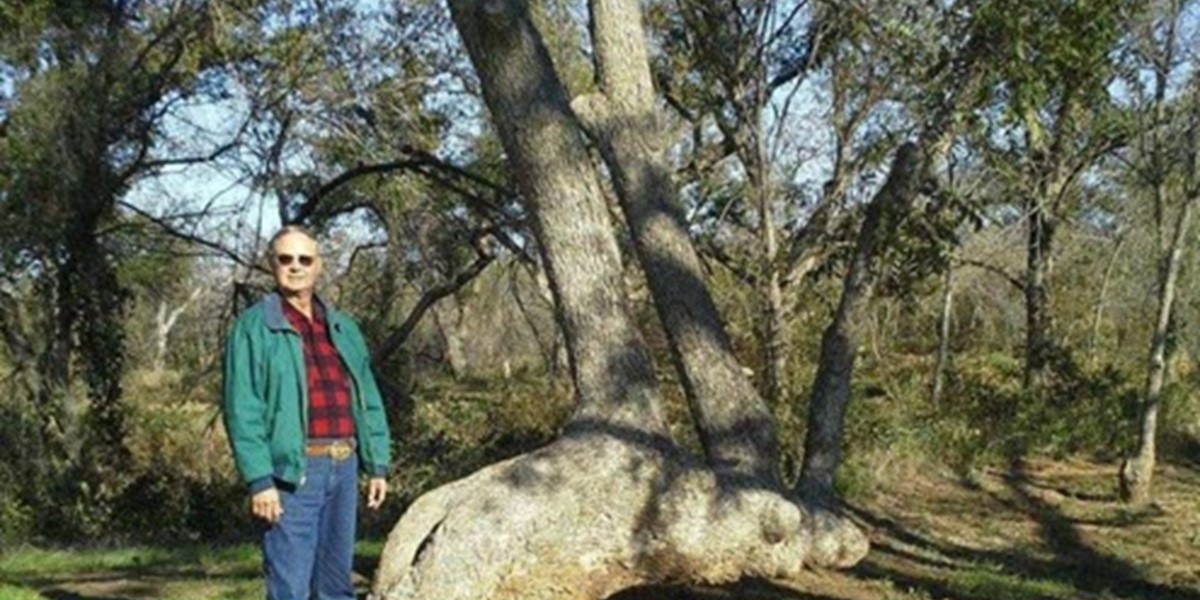

Published November 24, 2014 By LAUREN ZOTZ / ARCHER COUNTY NEWS
When Don Briix was a young boy growing up on a farm in northwest Oklahoma, he came upon a “Christmas tree rock”. When his parents told him it was actually an Indian arrowhead, it sparked a lifelong interest in Briix. “I thought to myself, ‘Indians probably had teepees right here where we live,’ and that fascinated me,” Briix said.
His fascination continued throughout his life and followed him to Texas when he and his wife, Pam, moved to Holliday in June 2010 to live near his daughter Angela Burroughs, and her family. And now his passion for learning and preserving history is making a difference in Archer County.
In December 2010 on a simple bike ride through Holliday’s Stonewall Jackson Camp #249, Briix saw an unusual tree, its trunk bent at a 90-degree angle, growing parallel to the ground, with three large trunk-like limbs growing perpendicular to the ground. He knew what it was. And he was excited about it.
Years earlier, Briix visited Florissant National Fossil Beds in Florissant, Colorado, where he learned about Indian marker trees from the park ranger there. The park ranger described how Indians would bend a sapling tree nearly to the ground, then tie it so it would be forced to grow in the precarious position. The park ranger went on to describe how the trees were used to mark Native American trails, water, campsites, graves, and to serve as medicinal or prayer trees. “He told me where I could find the tree and I found it. That conversation is what educated me. Before that I hadn’t heard anything about marker trees.”
So when he saw the tree in Stonewall Jackson Camp, a tree that looked just like the tree he saw in Colorado, he knew it had to be a marker tree. “There was just so much evidence of it being a true marker tree,” Briix said, indicating he was certain he was not mistaken.
Evidence, such as the age of the tree (at least as old as the last known existence of the tribe in the area), the type of tree (hardwood, such as pecan, oak, or walnut), certain scarring on the tree (deep scar lines where the tree grew around the tie-down, scarring where cut in order to bend more easily, and knobs where branches were cut off), and the location of the tree, often near a water source or creek to give direction for the tribe.
Though the story of the tree was written all over it, none of its history is documented. Pam Briix, a retired librarian said, “Even the oral history of the tree has been lost. No one around here was aware of the tree or its significance. We asked a lot of people about it but have not found anyone who knew about the tree.”
Thanks to Briix’ discovery, along with a combined effort of thorough research, leg work, phone calls, and paper-pushing by many individuals, the tree now has its place in history. One person who dedicates countless hours to the identification and confirmation of Indian marker trees is Steve Houser, Indian Marker Tree Coalition Committee Chair with the Texas Historic Tree Coalition.
In a letter addressed the mayor of Holliday, Houser stated that the tree has been accepted as an official Comanche Marker Tree by the Comanche Nation and will be added to the formal registry of the Texas Historic Tree Coalition.
Houser took careful measurements of the tree in 2011 and estimated it to be an estimated 250-300 years old and stated that all evidence corroborated with the tree being an authentic Indian Marker Tree. A formal report was compiled and respectfully submitted to the Comanche Nation and the result of the effort was finally rewarded when it was confirmed and accepted by the Comanche Nation.
“If it weren’t for the park ranger in Florissant doing his job, and doing it well, this would not have been brought to life,” Briix said of the marker tree official confirmation. But even more so, if Briix hadn’t brought his knowledge and keen eye to Texas, the Indian Marker Tree title would not have come into fruition, and the tree would simply be an oddly bent tree within the confines of the Stonewall Jackson Camp, none the wiser.
* * *
The public is invited to visit the Indian Marker Tree in Holliday’s Stonewall Jackson Camp #249, two miles south of Holliday on FM368. The tree is located about 85 yards south of the United Confederate Veterans Monument, behind the baseball field.
Though the camp is overseen by the City of Holliday, Briix has taken upon himself to serve as caretaker of the area surrounding the tree. “I had a sign made indicating the marker tree and took it upon myself to mow around the tree. To watch over it.”
The couple hopes others will bring their kids and grandkids to see the tree so the history of it can be enjoyed by many generations to come.
